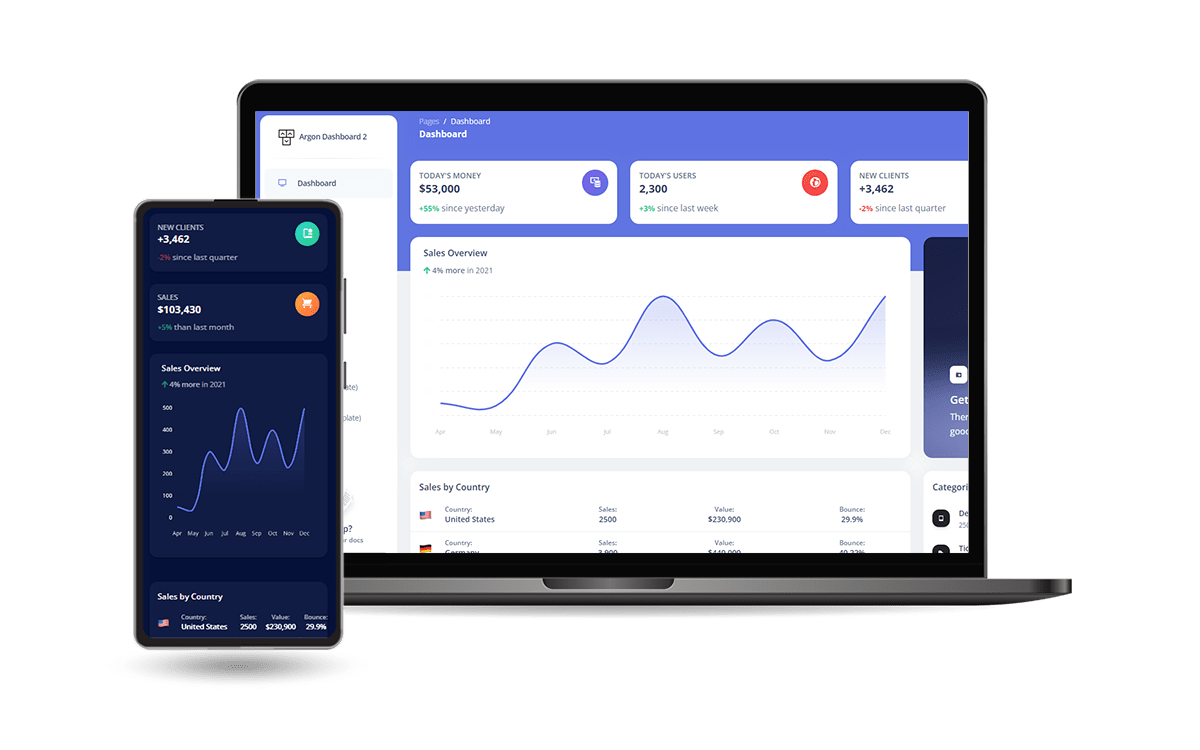Open-source Flask Dashboard generated by AppSeed on top of a modern design. Designed for those who like bold elements and beautiful websites, Argon Dashboard is ready to help you create stunning websites and web apps.
Argon Dashboard is built with over 70 frontend individual elements, like buttons, inputs, navbars, nav tabs, cards, or alerts, giving you the freedom of choosing and combining.
- 👉 Flask Argon Dashboard - product page
- 👉 Flask Argon Dashboard - LIVE deployment
Have questions?Contact Support (Email & Discord) provided by AppSeed
| Free Version | PRO Version | Custom Development |
|---|---|---|
| ✓ Up-to-date dependencies | Everything in Free, plus: | Everything in PRO, plus: |
| ✓ Best Practices | ✅ Premium Bootstrap 5 Design | ✅ 1mo Custom Development |
| ✓ DB: SQLite, MySql | ✅ PRO Support - Email & Discord | ✅ Team: PM, Developer, Tester |
| ✓ DB Tools: ORM, Flask-Migrate | ✅ Private REPO Access |
✅ Weekly Sprints |
| ✓ Session-Based authentication | - | ✅ Technical SPECS |
✓ Docker |
- | ✅ Documentation |
✓ CI/CD Flow via Render |
- | ✅ 30 days Delivery Warranty |
✓ Free Support |
- | - |
| --------------------------------- | --------------------------------- | --------------------------------- |
| ✓ LIVE Demo | 🚀 LIVE Demo PRO |
🛒 Order: $3,999 (GUMROAD) |
👉 Step 1 - Download the code from the GH repository (using
GIT)
$ git clone https://github.com/app-generator/flask-argon-dashboard.git
$ cd flask-argon-dashboard👉 Step 2 - Start the APP in
Docker
$ docker-compose up --build Visit http://localhost:5085 in your browser. The app should be up & running.
Download the code
$ git clone https://github.com/app-generator/flask-argon-dashboard.git
$ cd flask-argon-dashboardInstall modules via
VENV
$ virtualenv env
$ source env/bin/activate
$ pip3 install -r requirements.txtSet Up Flask Environment
$ export FLASK_APP=run.py
$ export FLASK_ENV=developmentStart the app
$ flask runAt this point, the app runs at http://127.0.0.1:5000/.
Install modules via
VENV(windows)
$ virtualenv env
$ .\env\Scripts\activate
$ pip3 install -r requirements.txt
Set Up Flask Environment
$ # CMD
$ set FLASK_APP=run.py
$ set FLASK_ENV=development
$
$ # Powershell
$ $env:FLASK_APP = ".\run.py"
$ $env:FLASK_ENV = "development"Start the app
$ flask runAt this point, the app runs at http://127.0.0.1:5000/.
By default, the app redirects guest users to authenticate. In order to access the private pages, follow this set up:
- Start the app via
flask run - Access the
registrationpage and create a new user:http://127.0.0.1:5000/register
- Access the
sign inpage and authenticatehttp://127.0.0.1:5000/login
The project is coded using blueprints, app factory pattern, dual configuration profile (development and production) and an intuitive structure presented bellow:
< PROJECT ROOT >
|
|-- apps/
| |
| |-- home/ # A simple app that serve HTML files
| | |-- routes.py # Define app routes
| |
| |-- authentication/ # Handles auth routes (login and register)
| | |-- routes.py # Define authentication routes
| | |-- models.py # Defines models
| | |-- forms.py # Define auth forms (login and register)
| |
| |-- static/
| | |-- <css, JS, images> # CSS files, Javascripts files
| |
| |-- templates/ # Templates used to render pages
| | |-- includes/ # HTML chunks and components
| | | |-- navigation.html # Top menu component
| | | |-- sidebar.html # Sidebar component
| | | |-- footer.html # App Footer
| | | |-- scripts.html # Scripts common to all pages
| | |
| | |-- layouts/ # Master pages
| | | |-- base-fullscreen.html # Used by Authentication pages
| | | |-- base.html # Used by common pages
| | |
| | |-- accounts/ # Authentication pages
| | | |-- login.html # Login page
| | | |-- register.html # Register page
| | |
| | |-- home/ # UI Kit Pages
| | |-- index.html # Index page
| | |-- 404-page.html # 404 page
| | |-- *.html # All other pages
| |
| config.py # Set up the app
| __init__.py # Initialize the app
|
|-- requirements.txt # App Dependencies
|
|-- .env # Inject Configuration via Environment
|-- run.py # Start the app - WSGI gateway
|
|-- ************************************************************************To update the CSS, the recommended way is this:
- use a Node 16.x version
- navigate to
apps/static/assets - Install modules using
yarnornpm i - Edit SCSS files
- Recompile SCSS -> CSS via
gulp scss - Refresh the browser
For more components, pages and priority on support, feel free to take a look at this amazing starter:
Argon Dashboard is a premium Bootstrap Design now available for download in Flask. Made of hundred of elements, designed blocks, and fully coded pages, Argon Dashboard PRO is ready to help you create stunning websites and web apps.
- 👉 Argon Dashboard PRO Flask - Product Page
- 👉 Argon Dashboard PRO Flask - LIVE Demo
Flask Argon Dashboard - Open-source starter generated by App Generator.

